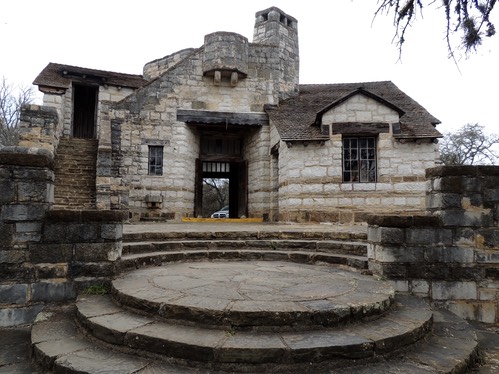Published in the La Vernia News on March 3, 2015
Gunpowder and Guano
Fascinating Formations, Confederate History, all in the Longhorn Cravens
Everyday Journeys
Harry and Linda Kaye Perez

The 120-mile drive between LaVernia and the Longhorn Cavern State Park is a beautiful one, especially in the spring when the wildflowers are blooming. But it really doesn’t matter when you visit; the cavern is virtually unchangeable.
Comanche Indians used the cave for shelter until chased away in about 1860 by the Confederate Army so that they could manufacture gunpowder. After the Civil War, the Indians returned to their underground shelter. In the 1920s and during prohibition, part of the cavern was used as a speakeasy and restaurant. One of the rooms was used for theater presentations and religious services. In 1931 the State of Texas purchased the cavern and the surrounding ranchland and the Longhorn State Park was born.
Situated between Marble Falls and Burnet on Park Road 4, we have the Civilian Conservation Corps (CCC) to thank, in part, for this jewel. In 1934, more than 600 young men, members of the CCC, began the arduous task of hauling over two tons of silt, debris, and bat guano out of the underground river-formed limestone cavern. They also mapped passageways, installed miles of lighting, built roads, an administration building and an observation tower. All the stone used for the buildings and the cavern entrance and stairway (the 52 steps that leads visitors into the cavern) were quarried from within the park. The cleanup and building processes took eight years.

A total of eleven miles of the cavern has been explored, although the guided 90-minute tour is just over a mile round trip. Once visitors make their way down 52 steps the terrain in the cave is mostly level. Wear comfortable non-slip shoes and, since the cave stays at a constant 65 degrees, you may want to bring a light jacket. Many of the rooms are large enough to host private events, such as weddings, birthday parties, or musical performances. Among some of the chambers that you can explore inside Longhorn Caverns include the Queens Throne Room, the Indian Council Room, the Hall of Marble with its smooth alabaster walls, the colorful highlights of the Rainbow Room and the most impressive of all, the Hall of Gems.
In addition to the cave tours, Longhorn State Park is a beautiful place to spend the day. You can walk several well-marked trails, have a picnic at a shaded table or enjoy the Grill and Snack Bar inside the Visitor Center. You can explore the Observation Tower and learn more about the creation of the park at the park museum housed in the original Visitor Center. If you are interested in geocaching, there are three private caches and one by the Texas State Park System just waiting to be found.
There is no fee charged to enter the park or use any of the facilities, except for the guided cave tours, ranging from $12 to $16 per person. If you have a Texas State Parks Pass you can get a $3.00 discount. Dogs are allowed to visit the outside areas of the park if kept on a leash; pets are not allowed inside the cavern or buildings. It is estimated that 40,000 to 45,000 people visit the cavern each year.

Observation Tower
Find Out More
Longhorn Cravens
6211 Park Road 4 South,
Burnet, Texas